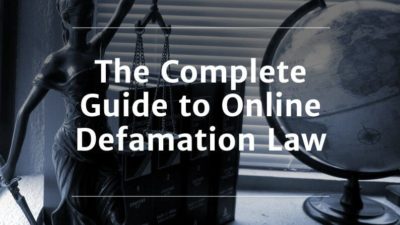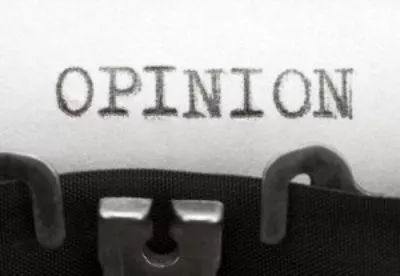
Why Should I Hire An Attorney To Send A DMCA Takedown Notice?
This page has been peer-reviewed, fact-checked, and edited by qualified attorneys to ensure substantive accuracy and coverage.
One of the most effective ways for an Internet attorney to remove online content is by filing a Digital Millennium Copyright Act (DMCA) takedown notice. A DMCA can be filed with webmasters, web hosts, and/or a website’s Internet Service Provider (“ISP”).
In this blog post, we’re going to address what a DMCA is, a case example of what can go wrong when filing a DMCA takedown notice, The Communications Decency Act, how to pursue alternative methods to removing unsavory information and photos from the Internet, and last but not least, whether you should hire an attorney to send a DMCA takedown notice.
Defamation Law Fact: Parties who publish and communicate defamatory statements and information are typically referred to as defamers, libelers, slanderers, and the less commonly known – famacide.
With a team of experienced attorneys, we will fight for the closure you deserve. Take back control today.Don't suffer in silence.
What is the DMCA?
First off, a DMCA takedown is commonly used in situations where a person or author finds unauthorized content of theirs (photographs, videos, profiles, stories, other information that is legally yours) on a website(s) which infringes their copyright to the material on a website. In order to successfully remove the information, injured parties are required to prove various elements that the other party is infringing their copyright to the material and posting it in an unauthorized or sanction matter.
Although the procedure can appear easy enough – even to persons who aren’t attorneys or working in intellectual property – it’s not. In fact, any experienced intellectual property or Internet removal attorney can likely send one of these nice little letters (DMCA) in their sleep, as all that’s required under Section 512 of the DMCA is that a letter be sent and include the following six (6) elements.
- Name & Signature: The name and physical or electronic signature of the content owner (or an authorized agent) whose rights are allegedly being infringed;
- The Work: Identification and details of the copyrighted work claimed to being infringed;
- The Website: Identification of the infringing website (which can easily be obtained via WHOIS domain lookup service) and a copy of the URL or link where the infringing content is located;
- Contact Information: Contact information of the person sending the DMCA takedown letter. Such things include the party’s address, telephone number, and e-mail address;
- Good Faith Statement: A statement that the person sending the takedown notice has a good faith belief that the use of the material in the manner complained of is not authorized by the copyright owner, its agent, or the law; and
- Accuracy: A statement that the information in the notification is accurate, and under penalty of perjury, that the complaining party is authorized to act on behalf of the owner of an exclusive right that is allegedly being infringed.
Although the process and inclusion of the above six elements appears easy enough, persons without legal experience should not be endeavoring to send a DMCA takedown without the assistance of an experienced Internet removal attorney.
The reality of the situation is that the above six steps are actually more difficult and technical to comply with than they appear, and even innocent mistakes can lead to liability and damages.
Keep in mind that although the DMCA is part of US Copyright Law, it does not actually require the content to be copyrighted by the author (typically the photographer), in order to process and authorize the takedown.
Below is the case of Amy Tuteur v. Gina Crosley, 1:13-CV-10159-RGS, which is a perfect example of what can potentially go wrong with embarking on a DMCA takedown without proper assistance or foresight.
Defamation Law Tip: A DMCA takedown is an effective alternative to traditional defamation suits to remove online photos and other information because it permeates the near blanket immunity afforded to websites under Section 230 of the Communications Decency Act.
If you’ve found unsavory photographs or other information of you posted online, there may be more efficient methods to removing it than via a defamation claim. Reach out to the internet defamation removal lawyers of Minc Law today to discuss whether a DMCA takedown is the most effective method for removing private and embarrassing photos or information.
Keep in mind that just because you have the right to process a DMCA takedown notice, does not mean you should go about doing so on your own.
At Minc Law, we boast a nearly 100% removal rate, and have litigated in over 19 states and 3 countries. We’ve secured hundreds of takedowns and removals, and have worked tirelessly with content managers, website administrators, and third-party arbitration firms to secure swift and permanent removals.
Call us today to schedule your free, no-obligation initial consultation with an intake specialist at (216) 373-7706 or schedule a meeting online by filling out our online contact form.
At Minc Law, we’re here to fight for your reputation.
The Case of Amy Tuteur v. Gina Grosley
The Facts
On January 25th, 2013, the plaintiff, Amy Tuteur (“Tuteur”), an obstetrician-gynecologist from Massachusetts, filed a lawsuit against Gina Crosley-Corcoran (“Crosley”) based on a dispute arising out of several blog articles written by both Tuteur and Crosley, ultimately culminating in a DMCA takedown notice sent by Crosley to Tuteur’s blog host – BlueHost.
According to the complaint, both Tuteur and Crossley were involved in a particularly heated debate and bitter internet exchange regarding the merits and dangers of birthing a child at home, as opposed to at a hospital. The debate escalated, and eventually, Crosley published a blog post entitled, “This One’s For You, ‘Dr. Amy’,” which included a photograph of herself giving the middle finger – described by the court as “in a graphic hand pose” – to Tuteur. Tuteur published a rebuttal blog, including a picture of Crosley on her own website, which brings us to the crux of the DMCA takedown notice.
The DMCA Takedown
Since Tuteur had republished Crosley’s photograph – which Crosley owned the copyright to – and without Crosley’s consent, Crosley responded by sending a DMCA takedown notice to Tuteur’s website host – BlueHost), which caused quite a ruckus after BlueHost terminated Tuteur’s contract with them and disconnected access to her website.
Bad Faith
Subsequently, Tuteur responded to the shutdown by filing a lawsuit against Crosley, claiming that Crosley had failed to fulfill the requirements (think back to the six elements) for sending a DMCA. Tuteur argued Crosley ent the DMCA notice in bad faith, and claimed that the takedown was defective because it was obvious that the republishing of the photo was non-infringing and considered fair use under Copyright law; ev. The use of the photograph was completely legal and the takedown however was not.
Crosley met this by filing defensive motions arguing that her takedown notices was not filed in bad faith and she had innocently relied on an inaccurate interpretation of her counsel’s advice on the matter.
Intellectual Property Law Tip: Curious about the term “fair use” used in Tuteur v. Crosley? Look no further, fair use is a legal doctrine permitting limited use of copyrighted material without having to first gain approval or consent from the copyright holder. When determining whether something may be published under fair use, courts generally look to (1) the purpose and character of the use (is it commercial or nonprofit?), (2) the nature of the copyrighted work, (3) the substantiality of the portion used, and (4) the effect of the use on the potential market for the copyright holder.
On September, 2013, a District Court issued a ruling allowing the case to proceed on its merits, and ruled that Tuteur’s complaint could stand because it properly alleged that Crosley’s DMCA takedown notices were sent:
- In bad faith, &
- With actual knowledge that her takedown notice contained a material misrepresentation of fact.
The Court rejected the chance to adopt an objective test that would ultimately require those sending DMCA takedown notices to consider possible copyright defenses like fair use, and disregard a person’s subjective understanding and intent.
The Moral of the Story
The moral of Tuteur v. Corsley is that sending DMCA takedown notices are not as easy or straightforward as one might think, and if done incorrectly, the person sending the frivolous or bad-faith notice could end up being sued and subject to civil damages.
Although I believe that Crosley’s case is strong and will ultimately prevail (the case is still outstanding) given the facts alleged, the fact that she was subject to an out-of-state lawsuit in the first place is a loss in of itself.
If Crosley had received competent and robust legal advice concerning the elements and sending of the DMCA takedown, she may not have found herself in the position of being sued at all (and in another state). At the very least, Crosley can rely on the fact that she met with attorneys as a proper and good defense in this case, which I believe will ultimately allow her to prevail.
Libel Removal Tip: There’s several free effective tactics you can employ to suppress negative and embarrassing Internet search results. First, consider creating a blog and updating frequently, Google and other search engines love positive content. Second, make your social media profiles public and start commenting openly on other public pages. Third, link your social media accounts together, as this will create a more robust corpus of positive online information. Finally, if you want to combat online defamation and malicious attacks right as they happen, set up a Google Alerts account and input your name – doing so will allow you to be notified anytime your name is mentioned online or with a string of certain words.
Intellectual Property Exception to The Communications Decency Act
Most ISPs and websites who run on user-generated content (information submitted and curated by third-parties), rely on a landmark piece of Internet legislation, Section 230 of the Communications Decency Act, to skirt liability and removal obligations when defamatory material is found on their website.
Video: What is Section 230 of the Communications Decency Act?

Specifically, Section 230 of the Communications Decency Act reads,
“No provider or user of an interactive computer service shall be treated as the publisher or speaker of any information provided by another information content provider.”
As long as the website or ISP does not actually create or curate the content, they are no more liable than a phone company who has two conspirators discuss a crime over their telephone lines.
However, Section 230 has carved out several exceptions for when ISPs and websites may be held liable – and requires websites who are given notice of intellectual property infringement to remove it immediately.
There has been some confusion as to what types of intellectual property claims will allow for liability, with several courts having issued conflicting decisions. One court in mid-2016 ruled that the exception should only apply to federal intellectual property claims, such as:
- Copyright infringement,
- Trademark infringement, &
- Patents.
While another court held that the immunity does not extend to state right of publicity claims – the right of a person to control the commercial use of their image, name and likeness, or other parts of their identity.
Overall, this shouldn’t affect you in any significant way, and you should consult an experienced Internet removal attorney no matter what.
Ohio Defamation Fact: Ohio takes a traditionally broader stance than other states towards the definition of defamation of character and classifies it as, “A false statement that: causes injury to a person’s reputation; exposes him to public hatred, contempt, ridicule, shame, or disgrace; or affects him adversely in his trade or business.”
If you’d like to discuss your legal options further, we strongly recommend you reach out to an experienced defamation removal attorney. Our team of internet defamation lawyers know the ins and outs of defamation law and DMCA takedowns, and have secured hundreds of removals and takedowns – and, all for a flat, reasonable fee.
Reach out today by calling us at (216) 373-7706, or by filling out our contact form online.
Alternative Methods to Online Defamation Removal
The core of Section 230’s protection for websites is generated under the third prong of a three-part test, which holds that websites and ISPs will not be liable where:
- The defendant is a provider or user of an interactive computer service,
- The defendant is treated by the plaintiff as a “publisher or speaker” of the harmful, malicious, or otherwise defamatory information in question, &
- The information is actually provided and curated by a third-party.
Section 230 of the CDA has caused much controversy due to its perceived blanket immunity granted to websites and ISPs, however, there are still several exceptions you should acquaint yourself with (besides the intellectual property infringement exception).
Websites and ISPs will not enjoy the immunity granted under Section 230 where their website contains material and content when:
- Criminal law violations: User-generated content platforms and websites are typically immune from civil liability in most applicable cases, however, they aren’t immune from criminal liability. If any website or ISP violates local, state, or federal law, they will not enjoy the near-blanket immunity granted under the CDA. The most common instances are typically in cases of revenge porn, content with strong emphasis on obscenity, and in cases of sexual exploitation of minors.
- Promissory estoppel: Promissory estoppel is a legal doctrine which enables a party to hold a website liable in cases where the website or ISP issued particular statements waiving protection under the CDA. When such happens, parties may rely on such statements and websites and ISPs will be promissory estopped from relying on the CDA as a defense.
- Encouragement, facilitation, & posting of illegal content: Similar to the criminal law violations provision, the facilitation or encouragement by a website to post illegal content will not garner immunity under the CDA. Oftentimes, when dealing with user-generated content platforms, they will boast and support borderline statements encouraging users to either “expose a cheater today,” or something along those lines. The encouragement to post illegal content exception has been ruled on and upheld in two several federal appeals courts.
- Materially altered & curated content: There’s a certain point where an editor has made so many edits and change to a piece that it no longer is an original work by the author. As user-generated content platforms rely on content provided solely from third-parties, when they start dipping their pen in crafting it, that’s when they open themselves up to liability. Websites and ISPs for user-generated content operate in a similar manner to bookstores, libraries, and newsstands, who do not exert any influence or control over the creation of the content – they merely distribute it. When assessing whether you may rely on this particular exception, look to see if the website or ISP has materially altered the original content posted.
Defamation Law Fact: In the realm of defamation law, the United States is generally considered a pro-defendant jurisdiction due to its longstanding history and enforcement of the First Amendment and free speech, while European and other Commonwealth countries are typically considered pro-plaintiff. Beware of “forum shopping,” where plaintiffs scour jurisdictions to find the court that is most likely to side with their side.
Reach Out to the Defamation Lawyers of Minc Law to Discuss Whether Sending a DMCA is the Most Effective Removal Option For You
If you or your business have any questions about sending a DMCA takedown notice or believe that you’ve had content improperly removed because of a DMCA takedown, the Internet attorneys of Minc Law are here to assist you and help you explore your legal options. At Minc Law, we’ve secured hundreds of removals and takedowns, worked with site administrators, content managers, and third-party arbitration firms, and litigated in over 19 states and 3 countries.
We boast a nearly 100% removal rate, all for a flat, reasonable fee. Reach out today by calling us at (216) 373-7706, or by scheduling a meeting by filling our our online contact form.
Curious of what you can expect when working with the Internet and defamation attorneys of Minc Law?
- Respect & Courtesy: We understand how stressful and overwhelming online defamation and improperly posted information and photographs online is, therefore, know that we are always on your side. After all, your goals are our goals.
- Communication: Not only do we pride ourselves on open lines of communication and dialogue, we provide aggressive representation via respectful and compassionate counsel.
- We Get Results: Websites and businesses respond to Minc Law. Our nationally recognized defamation attorneys draw on business and technical experience to provide cost-effective removal solutions.
★★★★★
I used Minc’s services to get images of my mugshot removed from a couple websites. I have not had success getting the mugshots removed on my own since the website administrators would not respond to my messages. Minc successfully coordinated the removal of these mugshots and made the process simple. They were easy to work with and I would definitely recommend them to others seeking similar services.
Anonymous, June 3, 2020



